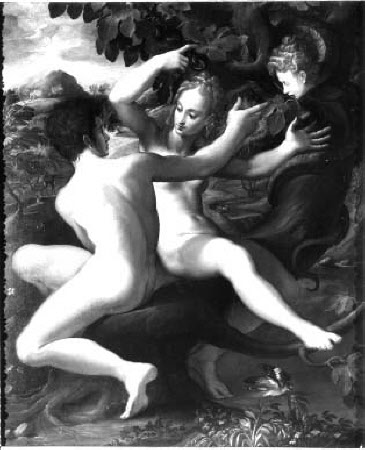The Temptation
studio of Girolamo Macchietti (Florence 1535 - 1592)
Category
Art / Oil paintings
Date
1570 - 1599
Materials
Oil on panel
Measurements
972 x 603 mm (38 1/4 x 23 3/4 in)
Place of origin
Italy
Order this imageCollection
Attingham Park, Shropshire
NT 608986
Caption
This picture was first catalogued as Bronzino, but comparison with a version in a private collection has prompted the attribution to Machietti’s studio. Machietti worked for six years with Giorgio Vasari on the redecoration of the Palazzo Vecchio in Florence. The contorted positions and expressive gestures are typical of Florentine art of this period. The scene is taken from the book of Genesis in The Bible, when Adam and Eve are tempted by Satan, in the form of a serpent, to eat from the Tree of Paradise, which was forbidden by God. This painting is unusual because a fig tree, rather than the more typical apple tree has been depicted. It seems that artists painted the fruit to which they were most accustomed, which is why the fig is often found in Italian painting. In Byzantine art, an apple or orange are most frequently found.
Summary
Oil painting on panel, The Temptation, studio of Girolamo Macchietti (Florence 1535 – 1592). Adam, naked, on the left, his back to the spectator, turned to left, but head turned to right with right profile, is seated beside Eve, also naked, on the horizontal trunk of the fig-tree, while Eve, turned to right but facing Adam to left, points to the human-headed serpent, left profile, regarding them from a branch on the top right corner; landscape setting. A pen and ink drawing on grey paper of Adam and Eve, attributed to Girolamo Macchietti (Florence 1535 – 1592), a follower of Parmigianino is at Bradley Manor (NT 830829).
Provenance
Attingham collection; bequeathed to the National Trust with the estate, house and contents of Attingham by Thomas Henry Noel-Hill, 8th Baron Berwick (1877-1947) on 15th May 1953.
Credit line
Attingham Park, The Berwick Collection (National Trust)
Marks and inscriptions
On reverse of panel (top): 28 On reverse of panel (bottom): 42 On reverse of panel (bottom): ATT/P/050 On reverse of frame (top): No. 15 On reverse of frame (top): 28 On reverse of frame (bottom): ATT/PF/050
Makers and roles
studio of Girolamo Macchietti (Florence 1535 - 1592), artist previously catalogued as attributed to Frans Floris the Elder (Antwerp c.1519 - Antwerp 1570), artist previously catalogued as attributed to Agnolo Bronzino (Monticelli 1503 - Florence 1572), artist

